吉林大学:《商务英语选读》课程电子教案(PPT课件)Unit 4 Text b Sharpening Your Basic Skills
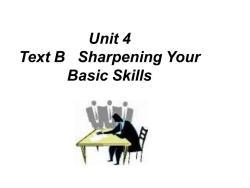
Unit 4 Text B Sharpening Your Basic Skills
Unit 4 Text B Sharpening Your Basic Skills
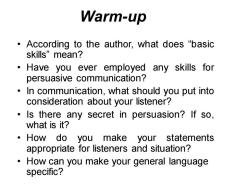
Warm-up ·According to the author,what does“basic skills'”mean? Have you ever employed any skills for persuasive communication? In communication,what should you put into consideration about your listener? Is there any secret in persuasion?If so, what is it? How do you make your statements appropriate for listeners and situation? How can you make your general language specific?
Warm-up • According to the author, what does “basic skills” mean? • Have you ever employed any skills for persuasive communication? • In communication, what should you put into consideration about your listener? • Is there any secret in persuasion? If so, what is it? • How do you make your statements appropriate for listeners and situation? • How can you make your general language specific?
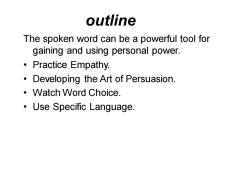
outline The spoken word can be a powerful tool for gaining and using personal power. ·Practice Empathy. Developing the Art of Persuasion. ·Vatch Word Choice. Use Specific Language
outline The spoken word can be a powerful tool for gaining and using personal power. • Practice Empathy. • Developing the Art of Persuasion. • Watch Word Choice. • Use Specific Language
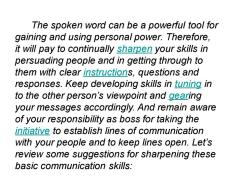
The spoken word can be a powerful tool for gaining and using personal power.Therefore, it will pay to continually sharpen your skills in persuading people and in getting through to them with clear instructions,questions and responses.Keep developing skills in tuning in to the other person's viewpoint and gearing your messages accordingly.And remain aware of your responsibility as boss for taking the initiative to establish lines of communication with your people and to keep lines open.Let's review some suggestions for sharpening these basic communication skills:
The spoken word can be a powerful tool for gaining and using personal power. Therefore, it will pay to continually sharpen your skills in persuading people and in getting through to them with clear instructions, questions and responses. Keep developing skills in tuning in to the other person’s viewpoint and gearing your messages accordingly. And remain aware of your responsibility as boss for taking the initiative to establish lines of communication with your people and to keep lines open. Let’s review some suggestions for sharpening these basic communication skills:

Practice Empathy. To be aware of what your listener will value as a payoff,try to put yourself in his or her shoes.How is your listener likely to feel about your message?What pressures is he or she under?How calm and confident is he or she feeling? What kind of relationship do you have? If the topic is controversial,is there anything the two of you can agree on to begin with?
Practice Empathy. • To be aware of what your listener will value as a payoff, try to put yourself in his or her shoes. How is your listener likely to feel about your message? What pressures is he or she under? How calm and confident is he or she feeling? What kind of relationship do you have? If the topic is controversial, is there anything the two of you can agree on to begin with?

Developing the Art of Persuasion. Remember that people usually base actions more on feeling,opinion,and beliefs than on logic and reason.A rational approach is one that considers all the variables,and in most situations there are many variables we cannot be sure of. True rationality also considers people's emotions and other "illogical"factors. Here is a five-step sequence for persuasive communication:
Developing the Art of Persuasion. • Remember that people usually base actions more on feeling, opinion, and beliefs than on logic and reason. A rational approach is one that considers all the variables, and in most situations there are many variables we cannot be sure of. True rationality also considers people’s emotions and other “illogical” factors. Here is a five-step sequence for persuasive communication:
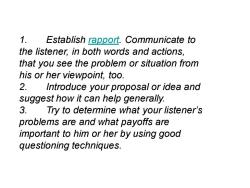
1. Establish rapport.Communicate to the listener,in both words and actions, that you see the problem or situation from his or her viewpoint,too. 2.Introduce your proposal or idea and suggest how it can help generally. 3.Try to determine what your listener's problems are and what payoffs are important to him or her by using good questioning techniques
1. Establish rapport. Communicate to the listener, in both words and actions, that you see the problem or situation from his or her viewpoint, too. 2. Introduce your proposal or idea and suggest how it can help generally. 3. Try to determine what your listener’s problems are and what payoffs are important to him or her by using good questioning techniques

4. Follow up with details to convince. Provide the listener with evidence that your proposal can help. 5.Maintain you credibility by avoiding too many strong adjectives,adverbs, superlatives,euphemism,or worn-out phrases:words that imply a certain knowledge of future events;and inappropriate surprise or amazement
4. Follow up with details to convince. Provide the listener with evidence that your proposal can help. 5. Maintain you credibility by avoiding too many strong adjectives, adverbs, superlatives, euphemism, or worn-out phrases: words that imply a certain knowledge of future events; and inappropriate surprise or amazement
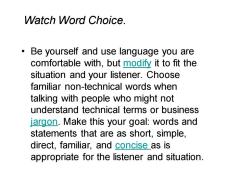
Watch Word Choice. Be yourself and use language you are comfortable with,but modify it to fit the situation and your listener.Choose familiar non-technical words when talking with people who might not understand technical terms or business jargon.Make this your goal:words and statements that are as short,simple, direct,familiar,and concise_as is appropriate for the listener and situation
Watch Word Choice. • Be yourself and use language you are comfortable with, but modify it to fit the situation and your listener. Choose familiar non-technical words when talking with people who might not understand technical terms or business jargon. Make this your goal: words and statements that are as short, simple, direct, familiar, and concise as is appropriate for the listener and situation
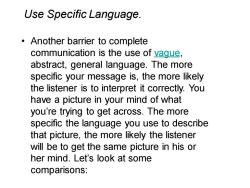
Use Specific Language. Another barrier to complete communication is the use of vaque abstract,general language.The more specific your message is,the more likely the listener is to interpret it correctly.You have a picture in your mind of what you're trying to get across.The more specific the language you use to describe that picture,the more likely the listener will be to get the same picture in his or her mind.Let's look at some comparisons:
Use Specific Language. • Another barrier to complete communication is the use of vague, abstract, general language. The more specific your message is, the more likely the listener is to interpret it correctly. You have a picture in your mind of what you’re trying to get across. The more specific the language you use to describe that picture, the more likely the listener will be to get the same picture in his or her mind. Let’s look at some comparisons:
按次数下载不扣除下载券;
注册用户24小时内重复下载只扣除一次;
顺序:VIP每日次数-->可用次数-->下载券;
- 吉林大学:《商务英语选读》课程电子教案(PPT课件)Unit 4 Text a Suggestions for Effective Listening.ppt
- 吉林大学:《商务英语选读》课程电子教案(PPT课件)Unit 3 Text c The Importance of Listening.ppt
- 吉林大学:《商务英语选读》课程电子教案(PPT课件)Unit 3 Text b How Can You Develop Effective Communication Skills?.ppt
- 吉林大学:《商务英语选读》课程电子教案(PPT课件)Unit 3 Text a Functions of On-the-job Communication.ppt
- 吉林大学:《商务英语选读》课程电子教案(PPT课件)Unit 2 Text c Levels of Communication.ppt
- 吉林大学:《商务英语选读》课程电子教案(PPT课件)Unit 2 Text b How to Start a Conversation in Britain.ppt
- 吉林大学:《商务英语选读》课程电子教案(PPT课件)Unit 2 Text a How to Be Entertained.ppt
- 吉林大学:《商务英语选读》课程电子教案(PPT课件)Unit 1 Text c Gift Giving.ppt
- 吉林大学:《商务英语选读》课程电子教案(PPT课件)Unit 1 Text b Handshake.ppt
- 吉林大学:《商务英语选读》课程电子教案(PPT课件)Unit 1 Text a Etiquette and Protocol in Business(主讲人:景超).ppt
- 吉林大学:《综合英语精读》课程PPT教学课件(四)Book 4 lesson 3 SOLVE THAT PROBLEM - WITH HUMOR.ppt
- 吉林大学:《综合英语精读》课程PPT教学课件(四)Book 4 lesson 2 A Dill Pickle.ppt
- 吉林大学:《综合英语精读》课程PPT教学课件(四)Book 4 lesson 1 The Pleasure of learning.ppt
- 吉林大学:《综合英语精读》课程PPT教学课件(三)lesson 17 Multinational Corporations.ppt
- 吉林大学:《综合英语精读》课程PPT教学课件(三)lesson 16 The Oyster and the Pearl.ppt
- 吉林大学:《综合英语精读》课程PPT教学课件(三)lesson 15 A Horseman in the Sky.ppt
- 吉林大学:《综合英语精读》课程PPT教学课件(三)lesson 14 The Odour of Cheese.ppt
- 吉林大学:《综合英语精读》课程PPT教学课件(三)lesson 13 Mr. Imagination.ppt
- 吉林大学:《综合英语精读》课程PPT教学课件(二)lesson 12 Farewell, My Unlovely.ppt
- 吉林大学:《综合英语精读》课程PPT教学课件(二)lesson 11 Diogenes and Alexander(主讲人:郑世华).ppt
- 吉林大学:《商务英语选读》课程电子教案(PPT课件)Unit 4 Text c How to Argue.ppt
- 吉林大学:《商务英语选读》课程电子教案(PPT课件)Unit 5 Text a Oral Presentation.ppt
- 吉林大学:《商务英语选读》课程电子教案(PPT课件)Unit 5 Text b Nonverbal Communication.ppt
- 吉林大学:《商务英语选读》课程电子教案(PPT课件)Unit 5 Text c Good Body Language Is Part of Good Communication.ppt
- 吉林大学:《商务英语选读》课程电子教案(PPT课件)Unit 6 Text a How to Understand Body Language.ppt
- 吉林大学:《商务英语选读》课程电子教案(PPT课件)Unit 6 Text b Business Communication.ppt
- 吉林大学:《商务英语选读》课程电子教案(PPT课件)Unit 6 Text c Culture and Communication.ppt
- 吉林大学:《商务英语选读》课程电子教案(PPT课件)Unit 7 Text a Barrier to International communication.ppt
- 吉林大学:《商务英语选读》课程电子教案(PPT课件)Unit 7 Text b Written Communication.ppt
- 吉林大学:《商务英语选读》课程电子教案(PPT课件)Unit 7 Text c Cultural Differences.ppt
- 吉林大学:《商务英语选读》课程电子教案(PPT课件)Unit 8 Text a Guides to Good Intercultural Communication.ppt
- 吉林大学:《商务英语选读》课程电子教案(PPT课件)Unit 8 Text b Case Study - Communication Skills.ppt
- 吉林大学:《商务英语选读》课程电子教案(PPT课件)Unit 8 Text c Case Study - Oral Communication.ppt
- 吉林大学:《大学英语泛读》课程PPT教学课件(book 3)Unit 1 Reading for A’s.ppt
- 吉林大学:《大学英语泛读》课程PPT教学课件(book 3)Unit 2 Why Not Speed Up Your Reading?.ppt
- 吉林大学:《大学英语泛读》课程PPT教学课件(book 3)Unit 3 Romantic Roundabout.ppt
- 吉林大学:《大学英语泛读》课程PPT教学课件(book 3)Unit 4 The Lucky Archaeologist.ppt
- 吉林大学:《大学英语泛读》课程PPT教学课件(book 3)Unit 5 News of the Engagement.ppt
- 吉林大学:《大学英语泛读》课程PPT教学课件(book 3)Unit 6 The Story of Jazz.ppt
- 吉林大学:《大学英语泛读》课程PPT教学课件(book 3)Unit 7 The Experiences of a Chinese Immigrant, 1880-1903.ppt
